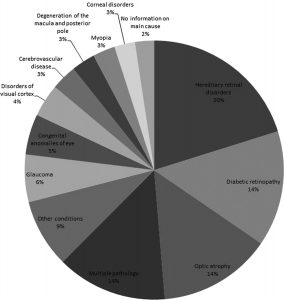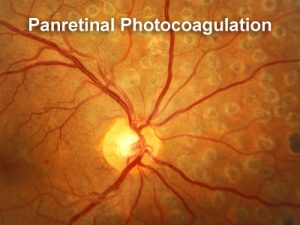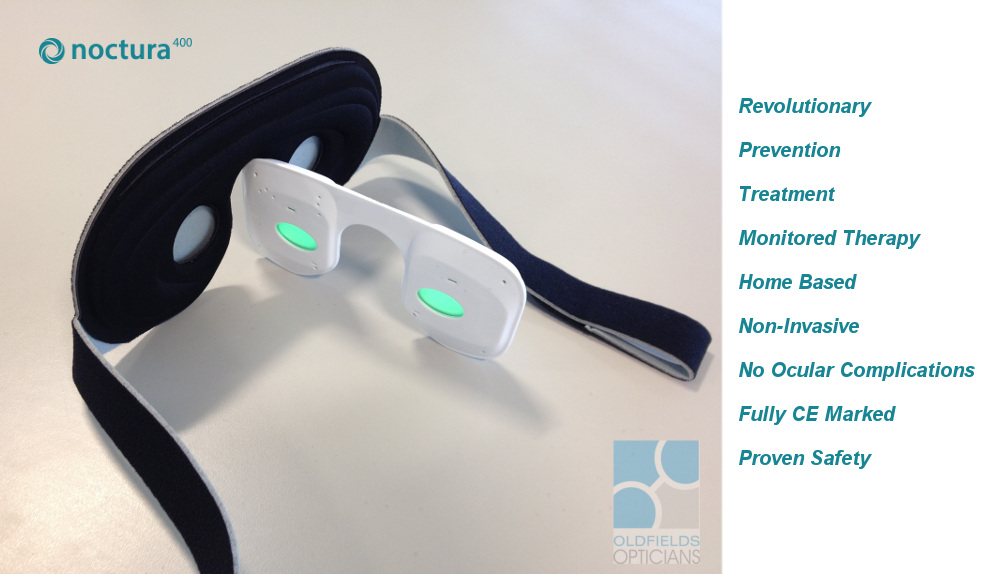Diabetic Retinopathy Treatment in London. Diabetes is a lifelong condition that causes a person’s blood sugar to become too high. As a consequence, there are a number of effects on the body. One of the major consequences is the effect on vision. Diabetes is the 2nd leading cause of blindness in the working age population of the UK.
National eye screening programs have possibly helped remove it from the top spot. Nevertheless, it is a disease that can have a massive impact on a person’s quality of life.

Main causes of severe sight impairment (blindness) in England and Wales in working age adults (age 16–64): certifications 2009–2010
The best way of controlling diabetic eye disease is through diet. As you body cannot handle spikes in blood sugar it is very important to control the sugar intake. The fluctuations in blood sugar can also cause changes to your eye power.
This means you may need to change your glasses more frequently. So you’ll be saving your money as well as your sight by keeping things under control. Always obtain advice from a dietitian before making major changes to your diet. You can asked to be referred to one through your GP.

Exercise is also just as important and has positive effects on your metabolism. Since your muscles require glucose to work, exercising draws glucose out of your blood, reducing your blood glucose level. Always seek advice from your GP when starting an exercise program if you have health problems or are on long term medication.
Making sure you turn up to your annual diabetic screening appointment. Regular checks of your blood glucose are extremely important for you to monitor your diabetic control. In the same way your diabetic eye screening checks are just as important.
The eye is the “window” through which the health of your tiny blood vessels can been seen. There is nowhere else in the body these tiny vessels can be seen by the naked eye or photography. They give your health care provider an insight of how well your diabetes is controlled.
Treatment of diabetic retinopathy
If your diabetes does progress to cause diabetic changes (diabetic retinopathy) in your eyes it may or may not require treatment. Background diabetic changes normally don’t require treatment. They represent very small leaks of blood into the retina. If these leaks occur at the macula (diabetic maculopathy) they can cause a drop in vision. In this case treatment will more likely be given.
For some time now the most common way to treat diabetic retinopathy has been with laser to the leaky vessels on the retina. This has carried with it the risk of damage to the retina itself and a deterioration in vision as further laser treatments need to be given.
There are also injections available for treatment of diabetic maculopathy. If the disease progresses further the retina can begin becoming short of oxygen. At this stage (proliferative diabetic retinopathy) signals are produced that start a process to resupply the retina with oxygen (neovascularisation).
Since oxygen can only be transported to cells through the bloodstream, the only way of getting more oxygen in, is increasing the number of blood vessels. These new vessels tend to be extremely leaky.
At the late stages of the disease, one of the ways to deal with these vessels is using Pan-retinal Photocoagulation.
The truth about retinal Photocoagulation
Ever wondered what pan-retinal photocoagulation means? It is a treatment needed for proliferative diabetic retinopathy, when your retina, being starved of oxygen starts to manically produce new blood vessels to try and bring in more oxygen. This is what a leading Ophthalmology site says about it.

“It is clinical practice to deliver mild to moderate laser burns that produce a light grey spot on the retina. Such a mild to moderate laser application will coagulate the retinal pigment epithelium and the adjacent photoreceptors, but leave the inner retina intact (see Figure 1).1The photoreceptors use more oxygen than most cells in the body and destroying them is an effective way of reducing the oxygen consumption of the retina.
What does coagulating the photoreceptors mean? Well, it is another way of saying “killing off the photoreceptors”. This reduces the oxygen demands of the retina and helps save the central sight, at the expense of the peripheral sight.
This means a person can no longer drive, see well in the dark and manage other day to day activities they took for granted.
Great new way to control diabetic eye disease
The good news is there’s a revolution coming to diabetic eye disease treatment. It is a new monitored therapy using light! Developed in Britain by Polyphotonix Medical LTD.
Introducing the Noctura400 Therapy for Diabetic Retinopathy. A revolution in diabetic eye disease management

Noctura 400 is a revolutionary new therapy for the treatment of diabetic retinopathy and diabetic macular oedema. It represents a radical departure from other treatments as it is non-invasive (NO laser, NO needles, NO surgery) and can be used by a person at home.
The Noctura 400 sleep mask consists of two parts, a fabric mask and a light emitting ‘pod’ that is inserted inside the mask. The pod contains two battery-powered organic light emitting diodes that when activated, are programmed to deliver the correct dose of light during the patient’s normal sleeping hours.
The light therapy has been designed so that it doesn’t interfere with your sleep and each mask records patient usage
This non- invasive (no laser, needles or blood!), monitored treatment works by keeping the cells in the peripheral retina, in a restful state. As a result the retina uses less oxygen and so it is no longer becoming starved of oxygen.
This means that there is no need to produce leaky blood vessels that cause havoc in the eye.
Treating Diabetic Retinopathy While You Sleep

Before you go to sleep, touch the ‘on’ sensor to activate the pod. The green lights will become visible and you then slide the pod into the fabric mask. The mask is worn every night, like a sleep mask.
Patients who have used it say it only takes a few days of getting used to. You can take it off in the middle of the night for a loo break, no problem. Its painless and has no side effects.
If you would like to find out more about this therapy you can contact us or book an appointment.
Watch the video below.
- The therapy can be used at any stage of diabetic retinopathy
- The therapy may help to slow, halt or even reverse the progression of the disease. The has been demonstrated in a number of clinical trials.
- The Noctura 400 is a CE marked medical device. (class IIa).
- There are over 700,000 hours of recorded use by patients to date
This therapy has been through trials and has been shown to demonstrate clinical repair in 66% of patients with no associated complications. Noctura400 has been evaluated in patients with;
- Mild to moderate non-proliferative Diabetic Retinopathy
- Early, untreated and progressive Diabetic Macular Oedema
- Moderate Proliferative Diabetic retinopathy
Costs for Diabetic Retinopathy and Diabetic Macular Oedema
Going private for diabetic eye disease treatment in London can cost thousands depending on the type of treatment you require. The two main treatments are laser photocoagulation and anti-VEGF injections to the eye.
The costs of the Diabetic Retinopathy Consultant’s time, and the cost per injection for DMO call all add up to a significant amount if you are paying for treatment privately.
My iClinic on High Road Finchley, North London charges £175 for a consultation and £1700 to £1750 per injection for the treatment of diabetic macula oedema.
Alternative diabetic macular oedema treatment
Fortunately, Noctura400 therapy costs significantly less. And you will be treating the underlying cause instead of the problem at hand.
The laser or injection treatment may be necessary for you if your situation needs to be addressed quickly, but if you do not want your diabetic eye disease to progress to this stage then doing something about it sooner is best.

The therapy costs £300 every 12 weeks. This works out to less than £4 a day. It includes the following:
- Dilated examination with digital photography and OCT every 6 or 12 months.
- 1x Pod with Quick Start Guide
- 3x Fabric Mask (disposable)
- 1x Instructions For Use
- 4x Pod Wipe
- 1x Return Envelope
- 1x Carrier Bag
Procedure:
- You will be required to sign a consent form
- The initial eye examination will be used to obtain baseline data You GP and/or Ophthalmologist will be informed of the start of your therapy
- You will be given your eye mask which is pre-programmed to work according to your sleeping patterns.
- Before the 12 weeks are up, a replacement mask will be sent to you so that your therapy remains uninterrupted.
- As this is a monitored therapy your usage data will be reviewed with you at your next appointment and the examination of your eyes each time will allow us to monitor the diabetic eye disease.
Natural macular oedema treatment
As this therapy is drug free, needle free and non-invasive, this makes it a natural macular oedema treatment method. Ask you Optometrist if this is appropriate for you as you may still needle to undergo treatment with injections at the same time.
Diabetic eye disease treatment in London
IQ Optometry has been accredited to provide this new therapy. To book a free telephone consultation with our Noctura400 accredited Optometrist fill out the form below.
Noctura400 has appeared in the press

And the newspapers

You can find out more information from the company that developed the Noctura400, including references for the above information at noctura.com
Footnotes
- http://bmjopen.bmj.com/content/4/2/e004015.full

